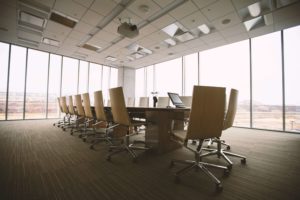And so it happened. Now well over a year since Covid-19 forced millions of us to work from home, we peer around the corner of comeback to a new hybrid, the future of work. A concept of remote working that has inevitably divided workforces, permanently creating a new normal.

As the fully vaccinated list grows, so HR teams and CEOs grapple to understand how best their workplace model should evolve. No longer simply to optimise commercial productivity, but now to focus on employee retention and the demand for greater flexibility and wellbeing, as we work in a combination of different ways and spaces.
These changing demands of virtual collaboration formed the keynote explored by a panel of experts at the EPOS* Global Media Day, earlier this month. Leading the debate were Professor Sir Cary Cooper, Professor of Organisational Psychology and Health at Manchester Business School, Torben Christiansen, Director of Technology at EPOS, and our very own Marta Vilella-Vila, Client Partner at Foresight Factory.
The concept of hybrid is not exclusive to the working world. Hybrid models are also emerging in leisure and retail. And it’s likely to be the predominant model post pandemic.
In the same way that we demand more from our online shopping experience, we will demand more from our online work experience. Makes sense, right?
But let’s keep things in perspective, as our research confirms only 35% of people in employment (so a minority), are planning to work from home MORE in the next 12 months, compared to life pre-pandemic. In Europe it’s even less, at 25%. Also supported by EPOS’s “Understanding Sound Experience Report 2021”, there is a discrepancy between the expectations of company decision-makers and employees about where people will work post-pandemic. 53% of global decision makers anticipate employees will work from the office, whereas just 26% of employees think the same. Conversely, 36% of employees believe they will work from home more compared to life before the pandemic, whereas only 30% of decision-makers think this.
 What’s more, there are significant regional disparities, as ONS data confirms. In London, around half the population worked at home at some point in 2020 (in affluent areas the figure was up to 70%), this compared to rural areas, where WFH accounted for less than 20%. And driven by this seismic difference in working patterns, we are faced with mammoth cultural and social divides, creating a polarising division between workers who can work remotely and those who cannot.
What’s more, there are significant regional disparities, as ONS data confirms. In London, around half the population worked at home at some point in 2020 (in affluent areas the figure was up to 70%), this compared to rural areas, where WFH accounted for less than 20%. And driven by this seismic difference in working patterns, we are faced with mammoth cultural and social divides, creating a polarising division between workers who can work remotely and those who cannot.
In all advanced economies, the number of workers who confirm their work-life balance has been impacted negatively during the pandemic is higher than those saying it got better.
And so, the idea of a more hybrid model that technically provides greater flex to pursue other interests and passions, and find alternative income generation opportunities, will be very much welcomed, especially by the younger part of the workforce.
Linked trend: Enterprise Nation. Consumers are adopting a more enterprising and flexible approach to income generation. They are fast becoming more entrepreneurial, in both mindset and action. Brands are invited to support the entrepreneurial mindset of the more commercially oriented consumer.
Most important for employers will be the need to provide support to employees in helping them achieve the best of both new worlds. Professor Sir Cary Cooper, Professor of Organizational Psychology and Health at Manchester Business School affirmed ‘The future needs line managers who are as strong technically, as they are emotionally, with a radar honed to recognise signs of mental health’.

In the office of the future, technology will play a central role in enabling employees to return to office buildings safely, but also to work effectively. To maintain productivity, collaboration and preserve the office culture, the obstacle of a split workforce, onsite and at home, must be overcome.
We all know office video conferencing can no longer consist of a team of people staring at each other around a table while others attempt, in vain, to engage from a screen in the side-lines. To be successful, Torben Christiansen, Director of Technology at EPOS confirmed the need for tech to “re-create the IRL experience, body language, and natural voice.” He believes “the office of the future will be more community focussed, a place to interact & innovate, a more exciting community & wellbeing space.”
So, if you’re facing similar dilemmas and stewing over how best to respond to the impact of Covid-19, why not let us help you to see beyond? You can apply our futures lens to your consumer, category or industry and find better answers. Click here for more information.
Notes:
* EPOS designs, manufactures, and sells pioneering high-end audio and video solutions for business professionals and serious gamers. More information at www.eposaudio.com